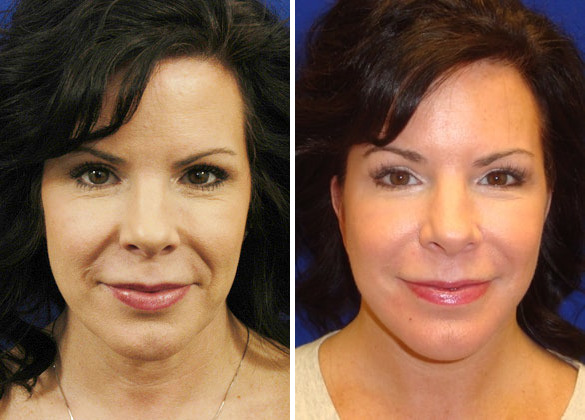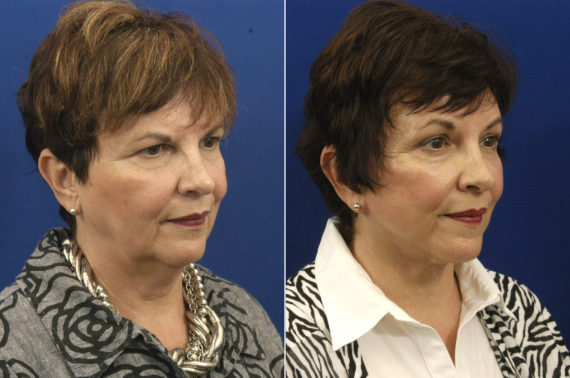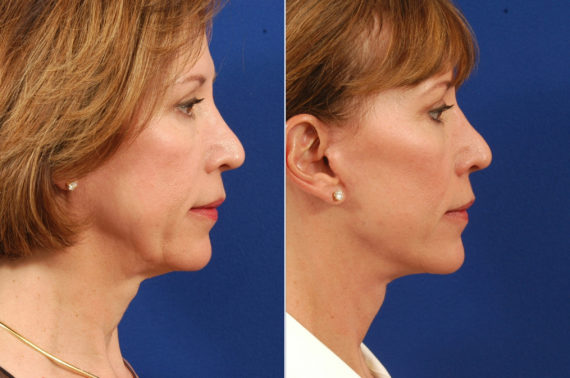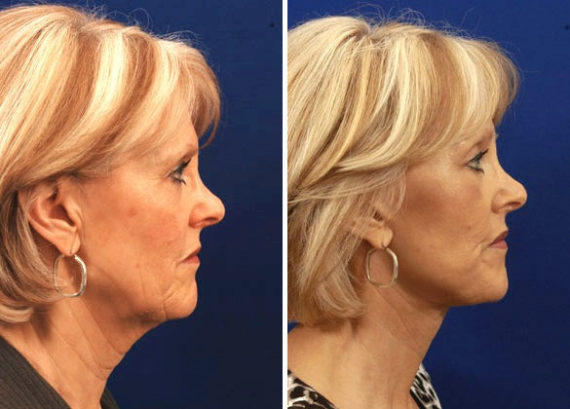SLOWING YOUR SKIN’S AGING PROCESS
An Inevitable fact of life
Aging is an inevitable fact of life, but thanks to modern times, you can slow or momentarily reverse the process. If you are discouraged because the face you see in the mirror looks older and more tired than you feel, a surgical procedure like a facelift can refresh your appearance and boost your self-confidence.
At the Hilger Face Center, our plastic surgeons provide high-quality results for patients interested in facelift surgery near the Minneapolis and Edina areas of Minnesota.
A facelift is a surgical procedure that is designed to reduce signs of aging in the face. This cosmetic procedure helps tighten sagging skin and remove wrinkles and fat from the face and neck. Knowing your options and understanding the target areas worked upon is crucial to making an informed decision.
WHAT IS A FACELIFT?
PROCEDURE OVERVIEW
A facelift, which may also be called a rhytidectomy, is a procedure to help reduce or eliminate visible signs of aging in the face or neck. As we age and our face loses elasticity, the middle of our face may begin to sag, or deep creases can develop around the eyelids or along the sides of our mouths.
Other reasons someone may want a facelift include a looseness of skin around the chin or jaw that creates the illusion of a double chin or the presence of jowls in the lower face.
A facelift is a surgical procedure. While topical treatments may help to fight the presence of wrinkles, they will not give the same benefits as a true facelift. There will be an obvious improvement especially in the contour, skin tone, and overall look of the skin in the face and the neck surgery. The natural enhancement creates a fresh look and a positive upbeat attitude.
FACELIFT TECHNIQUES
We offer different types of facelift techniques for patients in the Minneapolis and Edina areas, each one geared for specific aesthetic goals the patient may be looking for.
TRADITIONAL FACELIFT
The traditional facelift is a full lift that is used to rejuvenate the face and neck. This procedure includes the re-positioning of fat along with skin re-draping.
An inconspicuous incision is created beginning at the temple, traveling in front of and around the lower earlobe and then behind the ear descending to the lower scalp at the hairline. An additional incision may also be made under the chin when work is needed in that area.
MINI FACELIFT
Mini facelifts are less invasive and growing in popularity. They address aging on the face and jawline, providing a smoother and younger appearance. It typically takes two hours on average to complete and only one to two weeks to recover.
The procedure requires local anesthesia and mild sedative. A small S-shape incision will be made around the ears, and the skin is pulled up and re-draped, creating a tighter appearance. This reduces mid-face wrinkling and aging. It also creates less scarring than the traditional method.
LIMITED-INCISION FACELIFT
A limited incision facelift is a procedure that is performed through smaller incisions and is usually reserved for patients who require less aggressive surgery. Many patients are looking to have a flattering improvement in their appearance without any radical change and are considering surgery at an earlier age. With a limited incision, one is able to more easily hide the incision and the recovery is usually somewhat faster than a traditional incision. When limited rejuvenation is requested around the eyes, mouth, and nose, including nasolabial creases and folds, short incisions are created at the temples, around the ear, and in the lower eyelids.
NON-SURGICAL ALTERNATIVES
Some non-invasive surface treatments to the skin can provide some tightening of the soft tissues but the effectiveness is very limited and not equivalent to facelift surgery for any significant laxity. While increasing laxity of facial and neck skin are reasons to consider facelift surgery, many patients also experience a redistribution of soft tissue volume that is troublesome. This can be improved with minimally invasive techniques such as Kybella to reduce areas of excess volume or a volume loss in other areas with in-office treatment with Voluma or Lyft fillers.
Surgical Process for Facelift Procedures
Facelift surgery performed by our surgeons in Minneapolis is generally an outpatient procedure performed in two to three hours. Patients are sedated before the facelift procedure while the anesthesiologist stays nearby to keep the patient safe during the procedure.
The facelift surgery begins with an incision near the ear. The incision begins at the hairline and moves along the front of the ear, around the earlobe, and then back along with the ear and the hairline. This approach helps hide the incision after plastic surgery. A second incision is made on the opposite side of the face in the same way.
The skin is then carefully lifted from the underlying muscle and tissue. The surgeon may remove fat from the cheeks and the neck, then tighten up the bands of muscles and tissues around the neck below the chin. The multivector facelift technique we have developed produces superior results to methods used in the past. Excess skin is then trimmed away from the facial skin and is sutured into place.
AM I A GOOD CANDIDATE FOR A FACELIFT?
Our surgeons carefully screen your health records during a facelift consultation to make sure you are healthy enough for the procedure. Typically, good candidates will have realistic expectations for plastic surgery and have good enough physical health.
There are some patients who should avoid this type of surgery. Physical conditions such as high blood pressure, easy scarring, smoking, heart problems, and other serious conditions may make patients ineligible for facelift surgery. There are unusual medical conditions such as Ehlers-Danlos syndrome, in which the elasticity of the skin is very abnormal, and the results of surgery would be unacceptable for a face lift candidate. Some patients have general medical conditions that are contraindications to surgery which include patients who are on blood-thinners or significant amounts of immune-suppressant drugs.
COMPLEMENTARY PROCEDURES
There are other procedures commonly combined with facelift surgery, including eyelid rejuvenation or blepharoplasty surgery and brow lift surgery.
Facial signs of aging are ubiquitous and changes develop in the upper facial zone including the forehead, brow, eyelids, and periorbital areas. Thus for many patients, proper youthful facial harmony includes a brow lift, forehead lift, and/or eyelid surgery (blepharoplasty).
We are one of the few offices in the region that have 3D digital or video imaging available. During your consultation, we can help you appreciate harmonious changes that fit your desires.
-
What is the average age a woman gets a facelift?
-
How long does a facelift last?
-
How do I choose the best facelift surgeon?
-
What are the risks of facelift surgery?
-
What to do following my facelift surgery?
-
With so many less invasive alternatives to a traditional surgical facelift, when is the traditional lift the best option?
-
What is the risk of heavy scarring from a facelift?
-
What is the recovery process like?
-
How much does a facelift cost?
The most common age for a facelift is the mid-fifties.
Gravity is a constant and steady force that pulls on the tissues in the face and body. You may want to re-tighten your face-lift in seven to ten years to keep the tight and smooth look that you have achieved. However, the results of the face-lift have turned back time.
When making the decision to undergo facial rejuvenation, it is vital to choose the best facelift surgeon available. While any doctor can cut and suture, not all surgeons possess an eye for aesthetic beauty; a vital quality when trying to attain natural-looking facelift results. Make sure your surgeon is board-certified in facial plastic surgery and has a long history of performing a variety of procedures on the face and neck surgery. Look through your surgeon’s before and after photos, to get an idea of his skill and style; if you are happy with his previous work, you are more likely to be pleased with your results. The best facelift surgeon will sit down with you and develop an individualized surgical plan to achieve your facelift surgery goals.
The most common risk is developing a hematoma, which happens in approximately 3% of cases. The problem is easily treated and does not affect the eventual outcome of cosmetic surgery.
After your facelift surgery, you will generally spend a few hours in a recovery room. Once home, you must generally stay in a reclined position for 24 hours immediately after the cosmetic surgery. A soft diet is a must, and stretching or bending the neck should be avoided. Apply ice packs to reduce swelling and reduce bruising. We will remove your bandages the day after face lift surgery. The stitches or sutures are removed seven to ten days later.
Your question about less invasive alternatives for facial surgery is timely and excellent. There are some techniques that are minimally invasive and at the same time minimally effective and, therefore, we rarely use them. A traditional facelift operation addresses laxity in the cheeks, along the jaw line and laxity in the neck. Sometimes I’m able to carry out a short incision facelift for patients who have just soft tissue laxity in the cheek and along the jaw line. This involves smaller incisions around the ear. Occasionally, patients just have difficulty with neck laxity and this can be carried out with just the neck lift and no operation in the cheek area. Again, it is important that the soft tissues be elevated and re-suspended, and the fault of some lesser invasive procedures is that they do not accurately create a foundation that provides a lasting result.
The facelift are hidden in the hair or in natural creases around the ears. Unattractive scars are often the result of excess tension on the skin closure. The technique that we use avoids this and, in fact, the support of the deeper tissues also allows us to close the skin incision with very fine sutures with no tension, thus allowing for minimal scarring. Unfavorable scars are extremely uncommon. As a matter of fact, more than 80% of the sutures that we use are very fine and dissolvable. So, again, the likelihood of developing an unfavorable scar is quite remote.
Immediately following surgery, your face will be tightly wrapped in a bandage to put slight pressure on the incisions to minimize swelling and bruising. Each surgeon will have different requirements for how long you will need to stay in the hospital before you can return home.
Before you are released, they will go over the recommended way to clean the incision spots, which medicines you should take, and how to best take care of yourself while healing. For more information regarding helpful steps, visit our facelift post-op instructions page.
Recovery time will depend on the individual, how much work was done, and their body’s reaction to the surgery. Under most circumstances, you can expect to be in recovery for two to three weeks. During the first week of recovery, you will probably find that you do not want to do much other than rest and relax.
After a week or two, you may begin to feel better about leaving the house and interacting with other individuals or completing light chores. After about three weeks, you will probably feel ready to return to work and live as you did before the facelift surgery.
However, it may take up to three months for you to fully feel recovered from your facelift surgery. You should keep this in mind if you hope to get a facelift for an event or certain dates, such as a holiday, a trip, or a wedding.
Facelifts are an elective surgery and are therefore not covered by most insurance companies. Cost is broken down into several different factors: the surgeon’s fee, the facility fee, anesthesia, medications, surgical garments, medical tests, and more. They generally cost at least several thousand dollars. These exact costs vary depending on the details of the procedure best suited to your needs. We will share costs with you during your consultation.
While a facelift may be pricey for some, keep in mind that the surgery has the power to completely transform your appearance and boost your confidence. You should also keep in mind that you usually get exactly what you pay for when it comes to plastic surgery. Trying to find the best price usually means you will be unhappy with the results.





